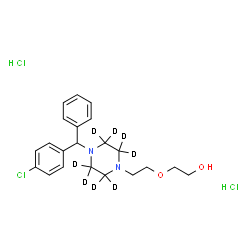Hydroxyzine-d8 (hydrochloride)
Modify Date: 2025-09-12 18:15:54

Hydroxyzine-d8 (hydrochloride) structure
|
Common Name | Hydroxyzine-d8 (hydrochloride) | ||
|---|---|---|---|---|
| CAS Number | 1808202-93-8 | Molecular Weight | 455.875 | |
| Density | N/A | Boiling Point | N/A | |
| Molecular Formula | C21H21D8Cl3N2O2 | Melting Point | N/A | |
| MSDS | N/A | Flash Point | N/A | |
Use of Hydroxyzine-d8 (hydrochloride)Hydroxyzine-d8 Dihydrochloride is the deuterium labeled Hydroxyzine dihydrochloride. Hydroxyzine dihydrochloride, a benzodiazepine antihistamine agent, acts as a orally active histamine H1-receptor and serotonin antagonist. Hydroxyzine dihydrochloride has anxiolytic effect and can be used forthe research of generalised anxiety disorder[1][2]. |
| Name | Hydroxyzine-d8 (hydrochloride) |
|---|---|
| Synonym | More Synonyms |
| Description | Hydroxyzine-d8 Dihydrochloride is the deuterium labeled Hydroxyzine dihydrochloride. Hydroxyzine dihydrochloride, a benzodiazepine antihistamine agent, acts as a orally active histamine H1-receptor and serotonin antagonist. Hydroxyzine dihydrochloride has anxiolytic effect and can be used forthe research of generalised anxiety disorder[1][2]. |
|---|---|
| Related Catalog | |
| In Vitro | Stable heavy isotopes of hydrogen, carbon, and other elements have been incorporated into drug molecules, largely as tracers for quantitation during the drug development process. Deuteration has gained attention because of its potential to affect the pharmacokinetic and metabolic profiles of drugs[1]. |
| References |
| Molecular Formula | C21H21D8Cl3N2O2 |
|---|---|
| Molecular Weight | 455.875 |
| Exact Mass | 454.179688 |
| Hydroxyzine-d8 (hydrochloride) |
| Ethanol, 2-[2-[4-[(4-chlorophenyl)phenylmethyl]-1-piperazinyl-2,2,3,3,5,5,6,6-d8]ethoxy]-, hydrochloride (1:2) |
| 2-(2-{4-[(4-Chlorophenyl)(phenyl)methyl](2H8)-1-piperazinyl}ethoxy)ethanol dihydrochloride |